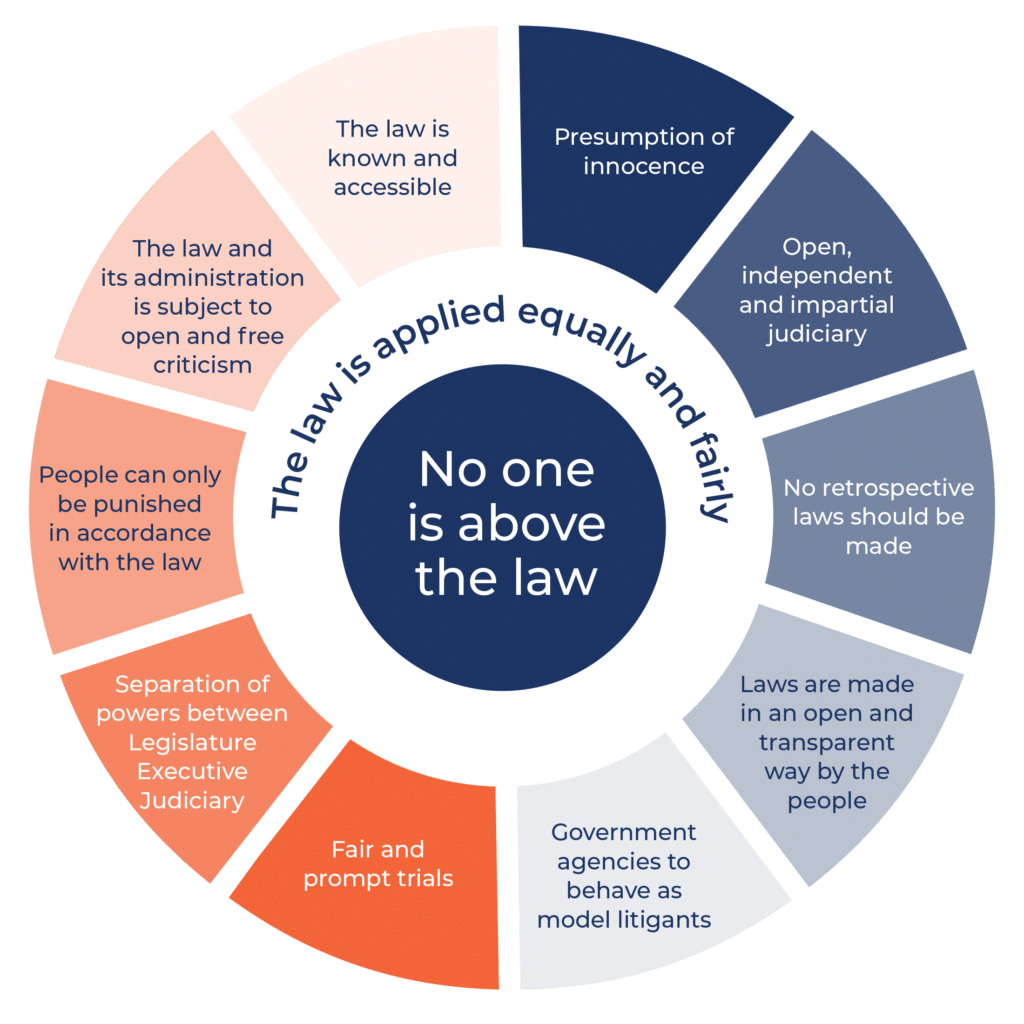Today marks the 65th anniversary of the High Court’s decision in Australian Communist Party v Commonwealth (1951) 83 CLR 1. This decision is recognised as one of the Court’s most important decisions, and a resounding reaffirmation of the rule of law, and judicial review of legislative actions.
This article will review the background to the case, and provide an in-depth analysis of each of the seven judgments delivered by the High Court bench.
The background of the case
On 19 October 1950, the Communist Party Dissolution Act 1950 (Cth) was passed by the Australian Parliament, at the behest of Robert Menzies’ Liberal-Country Party coalition government, who had swept to power in the federal elections just a year before.
The Act was one of the main planks of Menzies’ electoral platform, and was just the latest in a series of escalating measures designed to protect Australia against the various threats perceived to be posed by the Australian Communist Party and its fellow-travellers.
The Act purported to dissolve the Australian Communist Party, and to confiscate all its property. It also allowed the Governor-General, in council with the federal cabinet, to declare other communist or communist-affiliated organisations, like trade unions or certain newspapers, to be unlawful, with similar effects. The Governor-General in council could also issue similar declarations in respect of individuals, which then prevented the individual from being employed in the federal public service, or holding office in any trade union involved in any industry deemed to be “vital to the security and defence of Australia,” like the steel industry, or the ports. Neither of these declarations was open to real review by a court.
Famously, the Act also contained a preamble – a list of nine ‘recitals,’ or paragraphs – which outlined Parliament’s views on the dangers posed by communism, and purported to lay out the reasons why the Act was constitutionally valid. These recitals included ‘facts’ like:
The Australian Communist Party…engages in activities or operations designed to assist or accelerate the coming of a revolutionary situation, in which the Australian Communist Party, acting as a revolutionary minority, would be able to seize power and establish a dictatorship…
The Australian Communist Party also engages in activities or operations designed to bring about the overthrow or dislocation of the established system of government of Australia and the attainment of economic, industrial or political ends by force, violence, intimidation or fraudulent practices…
Certain industries are vital to the security and defence of Australia (including the coal-mining industry, the iron and steel industry, the engineering industry, the building industry, the transport industry and the power industry)…
Activities or operations of, or encouraged by, the Australian Communist Party, and activities or operations of, or encouraged by, members or officers of that party and other persons who are communists, are designed to cause, by means of strikes or stoppages of work, and have, by those means, caused dislocation, disruption or retardation of production of work in those vital industries…
It is necessary, for the security and defence of Australia and for the execution and maintenance of the Constitution and of the laws of the Commonwealth, that the Australian Communist Party, and bodies of persons affiliated with that party, should be dissolved and their property forfeited to the Commonwealth, and that members and officers of that party or of any of those bodies and other persons who are communists should be disqualified from employment by the Commonwealth and from holding office in an industrial organisation a substantial number of whose members are engaged in a vital industry…
This preamble was to attract a lot of attention during the ensuing court case, with arguments back and forth over whether the High Court should just accept Parliament’s reasoning, or whether it had a duty of its own to inquire into the situation.
The High Court challenge
The Act was challenged on the very same day that it received the Royal Assent from the Governor-General, and entered into law: 20 October 1950.
The plaintiffs challenging the Act included the Australian Communist Party, various trade unions from around the country, and a couple of editors from newspapers deemed to be communist-affiliated. The lawyers involved in the case included the elite of the Sydney and Melbourne legal communities. For example, three of the Commonwealth’s lawyers for this case were later appointed to the High Court: Sir Alan Taylor, who was appointed a couple of years later in 1952, Sir Victor Windeyer, who was appointed in 1958, and Sir Garfield Barwick, who became Chief Justice in 1964.
Against this array of talent, the plaintiffs controversially brought, amongst other lawyers, Herb “Doc” Evatt, who was a former High Court Justice himself, and, at the time, a current member of the Federal Parliament, and a future leader of the Australian Labor Party.
The stage was set for a major battle over the ambit of the federal government’s power to deal with what many people thought was a powerful and relentless enemy of Australia’s freedom and way of life: communism.
Click through the sections below to see more about the seven men playing key roles as the High Court justices hearing the case.
Sir John Greig Latham, GCMG KC (1877 – 1964)
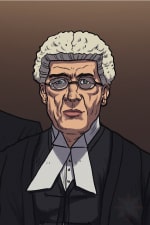 Latham was a conservative man. He served as an intelligence officer in the Royal Australian Navy during the First World War, later became head of Naval Intelligence in 1917, and was part of the Australian delegation to the Paris Peace Conference in 1919. His military service gave him a lifelong distrust of communism.
Latham was a conservative man. He served as an intelligence officer in the Royal Australian Navy during the First World War, later became head of Naval Intelligence in 1917, and was part of the Australian delegation to the Paris Peace Conference in 1919. His military service gave him a lifelong distrust of communism.
Later, he served as a politician in Federal Parliament, first as an independent, then for the Nationalist Party, and finally for the United Australia Party, the predecessor of today’s Liberal Party. Latham was Attorney-General during the British seamen’s strike of 1925, which spread around the world. Latham was a strong opponent of union militancy, and drove through changes to the Commonwealth Crimes Act to facilitate the deportation of two of the ringleaders of the strike in Australia. Later, he amended the Crimes Act again to make sending communist propaganda through the post an offence.
In 1935, he was appointed Chief Justice of the High Court by Prime Minister Joseph Lyons, and was succeeded as Member for Kooyong, and Attorney-General, by the young Robert Menzies, a future Prime Minister of Australia.
Sir Owen Dixon, OM, GCMG, KC (1886 – 1972)
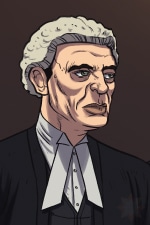 Dixon is widely regarded as one of Australia’s greatest judges; indeed, one of the greatest judges of the common law world.
Dixon is widely regarded as one of Australia’s greatest judges; indeed, one of the greatest judges of the common law world.
Dixon was a scholar of Greek and Latin classics, but still apparently an entertaining conversationalist, and during his time as a barrister in Melbourne, became close friends with Sir John Latham and Sir Robert Menzies. He was appointed to the High Court in 1929 by Prime Minister Stanley Bruce, on the advice of Latham, then Commonwealth Attorney-General, later to become Chief Justice. In later years, Dixon said he had never enjoyed being a judge, and much preferred being a barrister. Nevertheless, Dixon’s brilliance at legal reasoning, and skill at working with his sometimes difficult fellow judges, saw his appointment by Menzies as Chief Justice in 1952. Dixon also served as Australia’s ambassador to the United States for a few years during the Second World War, and was later appointed as a UN mediator between India and Pakistan over the status of Kashmir, where he wrote a report that some commentators continue to acknowledge as the best foundation for an agreement over that disputed territory.
However, Dixon, a staunch Anglophile, was also a supporter of the White Australia Policy, which he saw as protecting British interests in Australia. Similarly, his support for British interests manifested itself in strong anti-Catholicism.
Sir Edward Aloysius McTiernan, KBE (1892 – 1990)
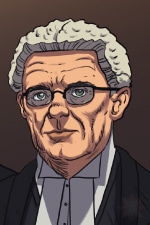 McTiernan is the longest-serving justice in the history of the High Court. A firm Catholic, he was known as a polite and quiet man, who never responded to the criticisms made of him and his appointment to the High Court.
McTiernan is the longest-serving justice in the history of the High Court. A firm Catholic, he was known as a polite and quiet man, who never responded to the criticisms made of him and his appointment to the High Court.
McTiernan had served in the New South Wales Parliament under firebrand Labor Premier Jack Lang, and was serving in Federal Parliament in the Australian Labor Party, when he was appointed by Prime Minister James Scullin in 1930, at the age of only 38. His appointment was criticised on the grounds that it was too “political,” and that McTiernan lacked sufficient legal experience. Nevertheless, he went on to serve as a High Court justice for another forty-six years.
He retired in 1976, after the Chief Justice of the time, Sir Garfield Barwick, a former Liberal politician, refused to include a wheelchair ramp in the design of the new High Court building, preventing McTiernan, who had broken his hip in a fall earlier that year, from accessing the building easily.
Sir Dudley Williams, KBE, MC, KC (1889 – 1963)
 Williams, like Latham, saw military service in the First World War, serving in the British Royal Field Artillery on the Western Front. He won the Military Cross, and was promoted to captain. After the war, he returned to Australia, and became a barrister, specialising in equity, intellectual property, and tax cases. He was another quiet and conservative man, who could not match the intellectual brilliance of colleagues like Owen Dixon or Wilfred Fullagar, but won a reputation as a hardworking, polite, and warm man, with a particular taste for sport and musicals.
Williams, like Latham, saw military service in the First World War, serving in the British Royal Field Artillery on the Western Front. He won the Military Cross, and was promoted to captain. After the war, he returned to Australia, and became a barrister, specialising in equity, intellectual property, and tax cases. He was another quiet and conservative man, who could not match the intellectual brilliance of colleagues like Owen Dixon or Wilfred Fullagar, but won a reputation as a hardworking, polite, and warm man, with a particular taste for sport and musicals.
He was appointed to the New South Wales Supreme Court in 1939, and elevated to the High Court by Prime Minister Robert Menzies in 1940. Towards the end of his career, he is said to have regretted this elevation, wishing he had stayed in New South Wales and focused on those equity cases which were his true professional love.
Sir William Flood Webb, KBE (1887 – 1972)
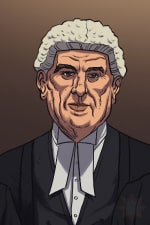 A grave and serious man, Webb is famous around the world for his time as president of the International Military Tribunal for the Far East, which tried Japanese military and political leaders for war crimes committed during the Second World War. During the Second World War, he was also commissioned to investigate and report on Japanese crimes in Papua New Guinea, and against Australian prisoners of war.
A grave and serious man, Webb is famous around the world for his time as president of the International Military Tribunal for the Far East, which tried Japanese military and political leaders for war crimes committed during the Second World War. During the Second World War, he was also commissioned to investigate and report on Japanese crimes in Papua New Guinea, and against Australian prisoners of war.
Although sometimes accused of Labor sympathies, and appointed to the High Court by Labor Prime Minister Ben Chifley in 1946, Webb remained so staunchly independent and non-partisan during his time on the bench that later commentators have described him as “colourless,” although admitting that he was extremely conscientious.
Sir Wilfred Kelsham Fullagar, KBE, KC (1892 – 1961)
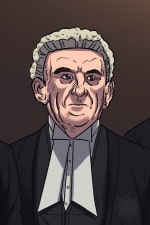 Fullagar was regarded as a brilliant judge around the world, and his death in 1961 brought rare tributes from the House of Lords in the United Kingdom, and the United States Supreme Court, as well as from his friend Sir Owen Dixon, who described him as having a “most lovable nature,” in addition to the depth and breadth of his learning, and his erudite writing style.
Fullagar was regarded as a brilliant judge around the world, and his death in 1961 brought rare tributes from the House of Lords in the United Kingdom, and the United States Supreme Court, as well as from his friend Sir Owen Dixon, who described him as having a “most lovable nature,” in addition to the depth and breadth of his learning, and his erudite writing style.
Dixon and Fullagar had been friends since their early days as barristers in Melbourne, where Dixon and Sir John Latham lent Fullagar the money he needed to go into business, and Fullagar and Dixon bonded over their shared love of Greek and Latin classics. After less than a year as a barrister, Fullagar was elevated to King’s Counsel, a prestigious appointment equivalent to becoming a senior barrister. He was appointed a judge of the Victorian Supreme Court in 1945, and elevated to the High Court by Prime Minister Robert Menzies in 1950.
Like Latham and Williams, Fullagar saw military service during the First World War, serving in the Australian Field Artillery.
Sir Frank Walter Kitto, AC, KBE, QC (1903– 1994)
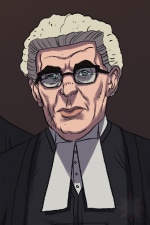 Kitto was another of Sir Robert Menzies’ conservative appointments to the High Court, being so elevated in 1950, and retiring only in 1970. An equity lawyer by trade, Kitto is remembered today often for his dense and complicated writing style. He was an opponent of judicial activism, or the introduction of policy concerns into judicial decision-making, calling it the introduction of “deleterious foreign matter in the water of the common law – in which, after all, we have no more than riparian rights.”
Kitto was another of Sir Robert Menzies’ conservative appointments to the High Court, being so elevated in 1950, and retiring only in 1970. An equity lawyer by trade, Kitto is remembered today often for his dense and complicated writing style. He was an opponent of judicial activism, or the introduction of policy concerns into judicial decision-making, calling it the introduction of “deleterious foreign matter in the water of the common law – in which, after all, we have no more than riparian rights.”
After retiring from the High Court, Kitto was the inaugural chairman of the Australian Press Council, arguing against the introduction of uniform national defamation and privacy laws, which he regarded as intrusions on the freedom of the press.
The issues in dispute
There were two questions asked of the High Court:
- Did the validity of the Communist Party Dissolution Act 1950 (Cth) depend only on the truth, or otherwise, of the ‘facts’ asserted by the nine recitals that formed the preamble of the Act?
- If that was not the proper test for the Act’s validity, was the Act invalid under some other test?
These two issues were the central points of argument during the case.
First, the parties argued whether the validity of the Act depended only on the truth of the ‘facts’ asserted in the preamble, and whether evidence could be adduced by both parties to prove or disprove these ‘facts.’
This might seem a strange issue to be debating, but it is actually very important. This is because it is really a debate about the relative power of Parliament and the judiciary. If the validity of the Act depended only on the truth of the preamble, then Parliament would be free to determine the limits of its own power, and the High Court would be reduced to being a minor branch of the federal government, unable to function as an effective check on the power of the legislature or the executive. If the Parliament said that the Australian Communist Party was a threat to the security of Australia, that would be that, and the High Court would not be able to challenge the validity of the Act.
What else would the validity of the Act depend on, other than the truth or falsity of the ‘facts’ asserted in the preamble?
In a word: power. In Australia’s system of government, the Federal Parliament cannot make laws about anything it wants; it is constrained by the Constitution, which lists those areas where the Parliament has power to make laws. If a federal law is not supported by one of these ‘heads of power,’ it is said to be ultra vires, or ‘beyond power.’ This means the law is invalid. This doctrine was crucial in the Communist Party case.
Indeed, the main debate in the case was over whether the Act was supported by one or more of the various heads of power listed in the Constitution. This came to be the main ground on which the validity of the Act was determined, rather than the truth or falsity of the ‘facts’ asserted in the preamble.
Two particular heads of power were the main focus: the defence power in s 51 (vi) of the Constitution, which gives the Federal Parliament the power to make laws with respect to “the naval and military defence of the Commonwealth and of the several States,” and the executive, or ‘nationhood,’ power in s 61 of the Constitution, which gives the executive branch of government power over “the execution and maintenance of [the] Constitution, and of the laws of the Commonwealth.”
Unless the Act could be classed within one of these two categories, it would be invalid.
Of the seven judges who heard the case, a majority of five answered the first question above ‘no,’ but answered the second question ‘yes,’ saying that the validity of the Communist Party Dissolution Act was not simply a matter of determining whether the asserted facts were correct; whether or not those facts were correct, the Act still had to fall within one of the enumerated powers of the Commonwealth. Since it didn’t, it was invalid.
Webb J was the only judge who answered ‘yes’ to both questions, arguing that the Commonwealth’s failure to prove the truth of the asserted ‘facts’ meant the Act was invalid.
In contrast, Latham CJ answered ‘no’ to both questions, holding that the Act was valid because it was supported by the defence power in s 51 (vi).
Click through the sections below to see an in-depth analysis of each of the seven individual judgments delivered by the High Court bench.
Latham CJ
First, Latham underlined the fundamental importance of defence policy, pointing out, quoting Oliver Cromwell, that “being comes before well-being.” In other words, the defence of the Commonwealth is a fundamentally important power, which, if not exercised properly, will preclude the exercise of any other powers of the Commonwealth, because there will be no Commonwealth.
Next, Latham argued that as well as being fundamentally important, defence policy is inherently political. It is not able to be determined only by appeal to facts that might be proven by evidence admissible in a court; it is often made based on a variety of factors, and involves many matters of ‘judgment.’
Comparing the possible danger of the Communist Party in Australia to the declarations of war in the First and Second World Wars, Latham pointed out that those declarations of war were viewed by some as necessary for the defence of the Australia, and by others as simply imperialist adventures; they involved a degree of judgment on the part of Parliament. However, neither declaration was made by the Court, or reviewed by the Court, and nor should they have been.
These two considerations, said Latham, made the defence power different from the other allocated to Federal Parliament by the Constitution. The Court ought to give Parliament more leeway in its exercise of the defence power. It was not up to courts, Latham argued, to second-guess Parliament in determining who the enemies of the Commonwealth were, and what level of danger they posed. They should only inquire into whether the means adopted by Parliament were consistent with the dangers that were supposed to exist.
In other words, the Court should have inquired whether the content of the Act was sufficiently connected with Parliament’s intention to alleviate the dangers posed by communists in Australia, but not whether Parliament was allowed to designate communists in Australia as posing that level of danger. Since the Act clearly adopted measures that would alleviate the danger said to be posed by communists in Australia, Latham argued, it was valid.
Dixon J
First, Dixon rejected the executive power of s 61 as a source of validity for the Act. As he said, this power is directed to maintaining government in the constitutionally-prescribed form; it is not a power to maintain the federal government at all costs. That power may also exist in extreme situations, but it is not to be found in the Constitution. All constitutional powers are governed by constitutional limitations and assumptions, and, for Dixon, one of the most important constitutional assumptions in this context is the rule of law. The vague phrases and lack of objective criteria of the Act, combined with the broad powers granted to the executive branch, violated some of the core tenets of the rule of law.
Next, Dixon turned to the defence power. He agreed that certain actions of the federal government which would be invalid in a time of peace, may be valid in times of war, because of the expanding nature of the defence power. He also acknowledged that Australian troops were fighting in the Korean War at the time the Act became law, and he acknowledged the various other international incidents which pointed to the growing enmity between communist and non-communist countries.
However, at the end of the day, Dixon said that the situation in Australia was not dangerous enough to justify such a law as a legitimate use of the defence power in s 51 (vi).
McTiernan J
Next, McTiernan distinguished between the powers of Parliament in a period of emergency, and a period of peace. In a period of emergency, Parliament’s powers expand, or rather the scope of the defence power enlarges, and Parliament may perhaps be allowed to designate certain individuals or organisations as security threats, and control their civil liberties. However, in a period of peace, the defence power is not large enough to encompass such legislation.
The question, McTiernan said, of whether a period is one of emergency or peace, and what measures should be taken, are questions for Parliament. However, the High Court retains its ability to decide whether the measures Parliament proposes have a reasonable relation to the emergency.
However, despite asserting that whether this was a period of peace or emergency is one for Parliament, McTiernan then went on to argue, like Dixon, that, at time the Act was passed, there was no emergency sufficient to give Parliament control over the civil liberties of communists; the defence power was not sufficiently enlarged. Thus, the Act was invalid.
Williams J
In other words, the question of whether a period is one of peace or emergency is something the Court should be thinking about too, not just Parliament. It is a central question to determining the extent of the defence power, and thus the validity of a lot of legislation.
Thus, Williams asked, what were the dangers to Australia’s security? Despite the fact that Australian troops were fighting in the Korean War at the time, Williams (as well as most of the other judges) said Australia’s security was not really threatened very much at all. The time was not one of “grave crisis,” during which “hostilities [are] waged on large scale,” like the Second World War had been. Thus, the defence power did not extend to this kind of legislation.
Williams also discussed the fact that the legislation, in the words of former High Court Chief Justice Sir Adrian Knox, “prohibits no act, enjoins no duty, creates no offence, imposes no sanction for disobedience to any command, prescribes no standard or rule of conduct,” but instead imposed penalties on certain individuals and organisation just because they existed, and were deemed to be a threat.
In other words, there were no objective criteria by which the behaviour of the individuals or organisation could be measured and criticised. Since the Court’s role, for Williams, was to examine exactly such objective criteria, and to decide whether they were reasonable, given the level of danger to Australia’s security, the Act was also problematic. An example of an Act that might have been more to Williams’ liking was the sedition provisions of the Crimes Act. There, certain types of behaviour were prohibited, rather than certain individuals and organisations being penalised.
Webb J
Reviewing previous case law, Webb came to the conclusion that, if the threat posed to Australia’s security by communists was only a short-term threat, then the Act would be invalid. This was because the severity of the consequences attaching to those people declared to be communists under the Act would be unreasonable and disproportionate to the danger they posed, and thus not supported by the defence power.
However, if the threat posed to Australia’s security by communists was a more long-term threat, the Act would be valid; the severe consequences would be reasonable and proportionate to the danger.
Thus, Webb said, it was the responsibility of the Commonwealth, who was arguing that the Act was valid, to prove that the ‘facts’ asserted in the preamble were true, and that the threat posed to Australia’s security by communists was a long-term threat. Since they didn’t attempt to do that, Webb found the Act was invalid.
Fullagar J
Fullagar’s judgment is most famous for his explanation of the two aspects of the defence power. He argued that the defence power supports two different sorts of laws. The primary aspect supports “laws which have, as their direct and immediate object, the naval and military defence of the Commonwealth.” This would include laws about enlistment, military training, ship building, and so on. These form the core of the zone of power granted to the Parliament by the defence power. This core will exist in times of war, and in times of peace.
The secondary aspect is more supplementary, and supports laws which are a bit further removed from the classical idea of naval and military defence, but yet still relevant. These include laws about food rationing, price controls, employment conditions in key industries, and so on.
However, Fullagar argued that it is typically only in situations like the “commencement or immediate apprehension of war,” or the “period necessary for post-war readjustment,” where this secondary aspect of the defence power has been recognised. In other words, some kind of grave crisis is necessary before the secondary aspect of the defence power arises. Without these conditions, only the primary aspect of the power exists. Deciding whether the necessary crisis exists, and the secondary aspect of the power has been enlivened, is a job for the Court.
In this case, Fullagar decided that the state of affairs that existed at the time the Act was passed was not grave enough to make the Act valid as an exercise of the secondary aspect of the defence power.
Fullagar also decided that the inherent power of the Commonwealth to protect itself against subversion could not support the Act. This was because this inherent power was also open to judicial investigation, and the Act did not provide an objective link between the individuals and organisation to be penalised, and the necessity of penalising them in order to protect the Commonwealth against subversion. Without such an objective link, Fullagar held, the Act could not be valid as an expression of this inherent power either.
Kitto J
In other words, while the “the necessity or desirability of [the Act], if it be within power, is a matter with which the courts have no concern,…the question whether the legal operation of the measure has such a capability of aiding defence as gives it that character which alone will sustain it as an exercise of the defence power is a matter which no judgment of the Parliament can conclusively decide.”
Kitto asserted that he doesn’t think the Act has such a character that links it to the defence power in s 51 (vi) of the Constitution, or any other enumerated power of Federal Parliament. Accordingly, the Act was invalid.
The Communist Party case and the rule of law
The Communist Party case has been recognised as one of the High Court’s most important judgments.
Despite the atmosphere of distrust concerning communism, and the clear democratic mandate granted to the incoming Menzies government to take strong action against suspected Communists, the High Court refused to withdraw from its role as protector of the constitutional order, and, perhaps more importantly, the rights and liberties of those facing the law.
Although the seven separate judgments of the Communist Party case muddle the High Court’s message a bit, and undermine the decision’s strength as a precedent for future threats to the rule of law, the case still represents a shining example of the power of a court to compel a democratically-elected government to obey the constitutional rules set down half a century before.
— William Shrubb
Further reading
‘Australian Communist Party v Commonwealth (1953) 83 CLR 1‘, High Court of Australia
‘The Australian Communist Party Case‘, Magna Carta Legacy website, Magna Carta Committee of the Rule of Law Institute of Australia


